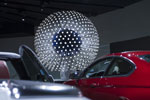
Until the end of January 2013, Osram shows its OLED installation "Dandelion" in the BMW museum in Munich, Germany.
The installation consists of about 1,000 organic light-emitting diodes, so-called OLEDs. Like its sibling the LED, an OLED is a semiconductor that converts electrical energy into light. While LEDs use a minuscule luminous chip to emit pinpoint light, OLED panels generate a lighting surface. To achieve this, various organic layers are vapored on a base material. The light-emitting layer of an OLED is approx. 400 nanometres thick – one hundredth the thickness of a human hair. When switched off, OLEDs can be reflective, neutrally white or transparent depending on the material used for the substrate.
Within the next years, OLED will find their way into car applications such as rear lights or decorative interior lighting as well.





